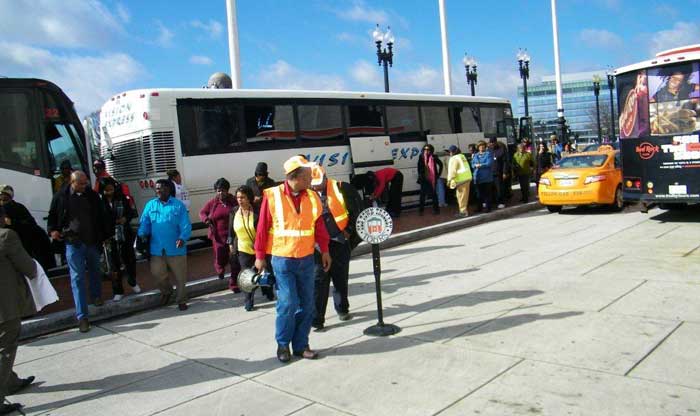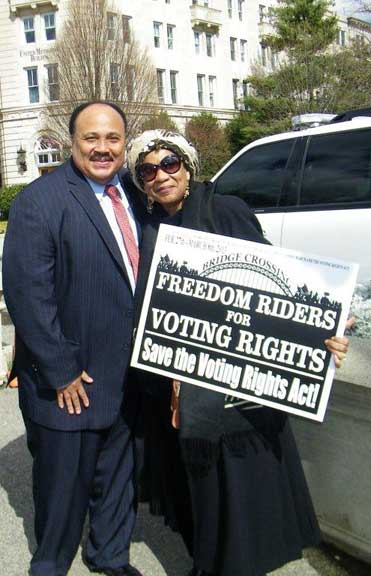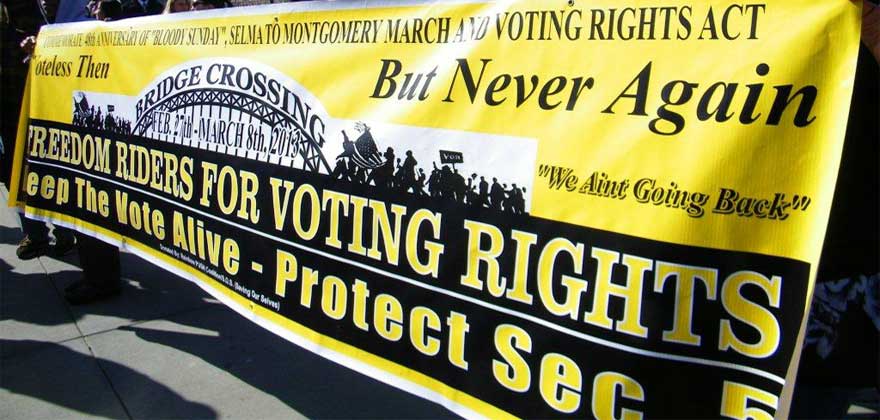Thank goodness that in 2013 we’re commemorating the Civil Rights milestones achieved through the sacrificial work of brave men and women who forfeited the pursuit of their own happiness to defend their constitutional rights and those of fellow citizens.
If it weren’t for the heightened awareness of history, those of us under 50 might not understand the inherent danger of Shelby County’s daring decision to challenge a provision of the 1965 Voting Rights Act that requires Alabama officials to get federal pre-clearance on any voting rule changes.
If we hadn’t been inundated with stories about struggles in the recent past, we might not have sensed the sinister undertones of the recent political posturing and legal wrangling over voter ID laws, polling place hours and changes in voting districts. We suspect their purpose was — is — voter suppression of ethnic minorities, college-aged adults, seniors and people in Democratic-leaning areas.
So I’m thankful that these younger adults are openly asking, why this flurry of activity around voting and voting rights? How is it that the Voting Rights Act, a crowning achievement of the Civil Rights Movement whose provisions were recently upheld by overwhelming majorities in Congress as recently as 2006, are now under attack?
Some people don’t want to think about the answer to those questions, but truth is best served in the bright light of reality.
And the truth is, it’s about a 2008 election of the nation’s first African-American president and a calculated, multi-billion dollar campaign to keep him from returning to office for a second time in 2012. (Sounds an awful lot like the vast “right-wing conspiracy” that Hillary Clinton mentioned years ago, doesn’t it?)
The calamitous failure of that campaign means the conspirators behind it are madder than ever and working now to find other means to achieve their political ends.
So now the U.S. Supreme Court, headed by five conservative justices, granted a February 27 hearing to Shelby County officials to assess whether they — and by extension, the other Southern states and jurisdictions bound under Section 5 of the Voting Rights Act — should be free to set their own election rules without federal oversight.
They point to the President Barack Obama and black elected officials across the South to say that times have changed. The essential argument in Shelby County and its national backers, Project on Fair Representation and Donors Trust, is that pre-clearance rules are not only unnecessary, but also unfair to Southern states who are being judged by what happened 50 years ago. Based on today’s voting patterns, everything is equal, Alabama is the same as California, so having the feds approve or disapprove their voting changes represents an unconstitutional infringement on their states’ sovereign rights.
 But the busloads of folks who left Alabama to protest with others from around the nation on the high court’s steps favored “keeping Section 5 alive.”
But the busloads of folks who left Alabama to protest with others from around the nation on the high court’s steps favored “keeping Section 5 alive.”
“I owe it to myself and the people who came after me – and to the people who came before me and paved the way for me – to go,” said Miles College student Amanda Vaughn as she prepared to leave for Washington, D.C. “I don’t want any progress that has been made to stop here.”
Fairfield resident Gilda Walker (pictured here with Martin Luther King, III) said the ride to D.C.  reminded her that even 50 years after the Birmingham Movement for civil rights and 48 years after Selma’s “Bloody Sunday” march for voting rights, fights for rights still have to be waged in Alabama.
reminded her that even 50 years after the Birmingham Movement for civil rights and 48 years after Selma’s “Bloody Sunday” march for voting rights, fights for rights still have to be waged in Alabama.
“Until I hear Shelby County say they want to fight for a new [state] constitution, I will never believe they are sincere about being fair” about voting rights, she said, because the framers of Alabama’s 1901 Constitution clearly stated that their goal was to maintain white male superiority.
Speakers at this year’s annual commemoration of the 1965 march for voting rights across the Edmund Pettus Bridge in Selma reminded the crowd of thousands that the South has a documented history of rolling back African-American voting rights, despite the 15th Amendment that gave Congress the power to secure those rights across all states.
It took 100 years of long, hard, and deadly struggling by African Americans and people of good conscience, particularly the people of Selma, to restore rights, the speakers said.
Those freedom fighters forced Alabama and other states and jurisdictions that suffered from the mental disease of racism to take strong medications. One of the cures was the Voting Rights Act of 1965, a cure that has, in fact, led to remarkable changes, including the election of the first black president. But there is danger when the mentally ill stop taking their meds.
Justice Stephen Breyer even made that analogy during the Supreme Court hearing last month when he called abridging a person’s right to vote under the Fifteenth Amendment because of skin color “the old disease.”
“It’s an old disease, it’s gotten a lot better, a lot better, but it’s still there,” he said to Shelby County’s lawyer, Bert Rein. “So if you had a remedy that really helped it work, but it wasn’t totally over, wouldn’t you keep that remedy?”
In an amicus curiae brief supporting the Justice Department in the Shelby County case, six political science and law professors found that racially polarized voting is more extreme in states fully and partially covered under Section 5 of the Voting Rights Act. The problem is more acute when minority groups grow in both numbers and political power in those states.
According to this and other data in their brief, the writers found that “Alabama ranks among the nation’s most discriminatory states by almost every metric,” and were puzzled that those arguing against Section 5 would forward Shelby County as Exhibit A.
The recent fiasco around the School Accountability Act shows that Alabama is determined to shoot its Shelby County case in the foot. Even with a supermajority, Republican lawmakers forced their will on the people of Alabama by secretly hashing out their new education plan with nary a fellow Democratic lawmaker in the room to cry foul. It seems to me that their plan essentially gives some families taxpayer dollars to send their children to segregation academies — uh, I mean, private schools.
So much for Shelby County and Alabama’s “equal dignity” among America’s states.
Sure, discriminatory practices, racism, anti-immigrant attitudes and all other forms of racial insanity still exist all over the country. But it’s particularly bad in most of those states like Alabama and jurisdictions like Shelby County still under Section 5 of the Voting Rights Act.
So until proof of the cure is as thoroughly documented as the disease, Alabama and the other areas currently under the supervision of Section 5 should remain under supervision. And they should stay on their medications.
Note: This perspective first appeared in Weld for Birmingham’s March 14-21 print edition and online here.


[…] Read the full blog post from March 16, 2013, at Birmingham View Blogs […]